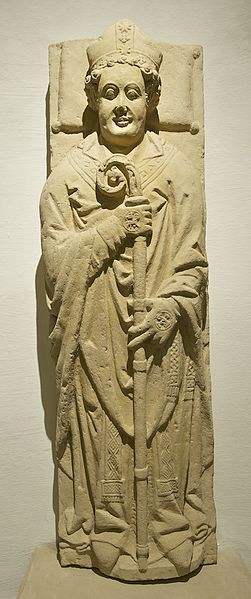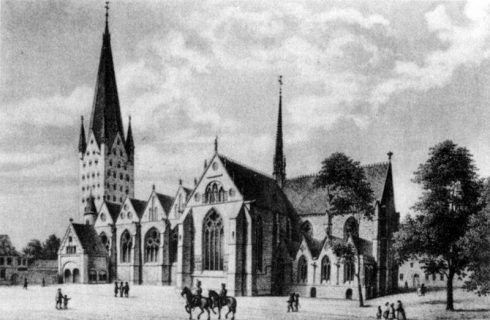Blessed Meinwerk
Tenth Bishop of Paderborn, d. 1036: Meinwerk (Meginwerk) was born of the noble family of the Immedinger and related to the royal house of Saxony.
His father was Imad (Immeth), Count of Teisterbant and Radichen, and his mother’s name was Adela (Adala, Athela). In early youth he was dedicated by his parents to serve God in the priesthood. He began his secular and ecclesiastical studies at the church of St. Stephen in Halberstadt and finished them at the cathedral school of Hildesheim, where he had as schoolmate St. Bernward of Hildesheim and probably the later Emperor Henry II. After his ordination he became a canon at Halberstadt, then chaplain at the Court of Otto III. Henry II, who greatly esteemed him, named him Bishop of Paderborn, for the express purpose of raising the financial condition of the impoverished church. He was consecrated at Goslar, 13 March, 1009, by Archbishop Willigis of Mainz. For twenty-seven years he laboured with restless energy and zeal, and deserves the title of second founder of the diocese. His cathedral and a large portion of Paderborn had been destroyed by a conflagration in 1000; he rebuilt the cathedral on a much grander scale and consecrated it on 15 Sept., 1015. He employed Greek workmen to build the chapel of St. Bartholomew, which was considered a work of art. In 1031 he founded the Abbey of Abdinghof, for which he obtained thirteen Benedictine monks from the Abbey of Cluny. Between the years 1033 – 36, he established the collegiate church for canons-regular at Bussdorf. He built an episcopal palace and new walls for the city. He divided his diocese into parishes, caused the erection of many churches and chapels, held frequent visitations, insisted on a clerical life among his priests, observance of rules in the monasteries, and was much interested, not only in the spiritual welfare of his subjects, but also in their temporal well-being, for which he introduced improved methods in agriculture, etc. According to his biography his own education was not of a high grade, but he did much for the spread of knowledge; he called in noted teachers of mathematics, astronomy, and of other sciences and put his cathedral school into a flourishing condition, which it retained for many years after his death, many prominent men receiving their education in it, among others, Altmann of Passau, Anno of Cologne, Frederic of Munster, and others.
To defray the expenses of his buildings and charitable works, he made use of church festivals, social gatherings, and other occasions to call upon the generosity of kings and princes, of the rich and noble, of the clergy and of the laity, frequently importuned the emperor himself, relying upon his friendship and often appealing to his own labours for the state; but he also very liberally used his personal means for the benefit of the Church. Towards his subjects Meinwerk was frequently harsh, but kind at heart, and, if any serious offence had been given, he would conciliate the party by presents. Twice he made a journey to Rome, the first time in 1014, to assist at the coronation of Henry II, then, in 1026, as companion of Otto III. On this trip he received from Wolfgang, Patriarch of Aquileia, the body of St. Felix for Abdinghof. Similarly he obtained for his diocese, entirely or in part, the relics of Sts. Valerian, Minias, Philip, Juvenal, and of the great martyr-bishop Blasius.
His body was buried, according to his wish, in the crypt of the church of Abdinghof. Abbot Conrad von Allenhause raised the relics and 25 April, 1376, placed them in a beautiful monument in the sanctuary. This has been considered equal to a canonization, but his feast is not in the Proprium of Paderborn of 1884, nor does the schema of the diocese for 1909 show any church, chapel, or altar dedicated to his name. On the secularization of Abdinghof, 1803, the remains were brought to the church of Bussdorf. The “Vita,” (Mon. Germ. SS., XI, 104), written anonymously by a monk of Abdinghof, soon after 1150, is a history, not a legend, though somewhat ornamented by legendary additions. (Giesebrecht, “Deutsche Kaiserzeit”, II, 578.)
Acta SS., June, I,.500; STADLER, Heiligenlex.; WATTENBACH, Deutsche Geschichtsquellen, II, 27, 30; EBELING, Die deutschen Bischofe, II (Leipzig, 1858), 346.
FRANCIS MERSHMAN (Catholic Encyclopedia)










